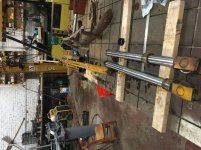badwithusernames
Aluminum
- Joined
- Sep 24, 2017
I'm currently rebuilding all of the hydraulic cylinders on my Allis Chalmers forklift. Four cylinders for the three stage mast and two tilt, new packing, wipers and seals for all of them. On the very last cylinder, (of course) the gland nut tightened up all of the sudden, about half way from fully seated. This was after very careful cleaning, and a test running the gland nuts in with the threads oiled. But, on assembly, it would suddenly not tighten, and did not want to loosen either. Heat and oil made no difference, and the pin spanner bent. Not sure what happened, I had been pretty sure everything was very clean. Anyway, I accepted that there was going to be some damage, and put a 4' bar on a pipe wrench to spring the gland nut out. The damage is brutal. And the cylinder is a cluster of three that are a welded assembly, so not easily replaceable unless I hunt down a used one..
So, on the gland nut I have used my lathe to trim off the damaged threads, and carefully cleaned up the lead thread. Because the cylinder assembly is massive and bulky, all I can do is make sure no more threads are loose or damaged. I have 7 full threads left, will this be enough to hold the gland nut on? I imagine if not, I could weld the gland nut on, and start the hunt for replacement cylinders..
Thoughts? Anything else I should try?
So, on the gland nut I have used my lathe to trim off the damaged threads, and carefully cleaned up the lead thread. Because the cylinder assembly is massive and bulky, all I can do is make sure no more threads are loose or damaged. I have 7 full threads left, will this be enough to hold the gland nut on? I imagine if not, I could weld the gland nut on, and start the hunt for replacement cylinders..
Thoughts? Anything else I should try?






